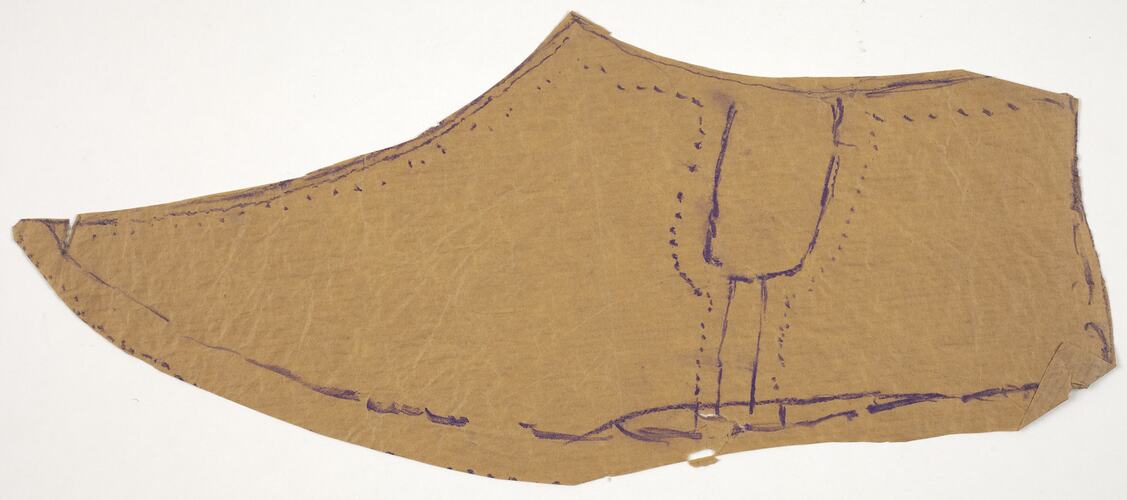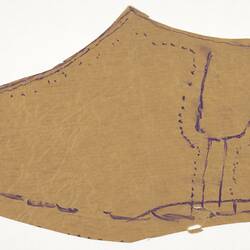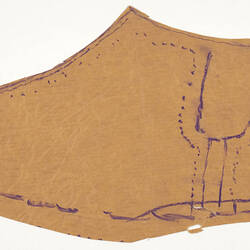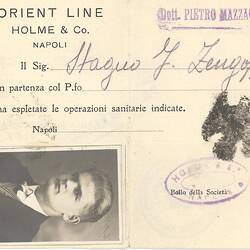Summary
This hand-cut flat soled short ankle boot pattern has been created from brown paper and was most likely used by Stanio Fancoff sometime around the 1960s. Characteristically similar to a short ankled 1964-1966 Italian men's boot this simple generic design was used within the making of Stanio's various boot styles. Amongst many others, this pattern is part of the shoemaking designer kit that enabled Stanio to acquire versatility and different fashions within his shoemaking trade.
Stanio Ivanoff Fancoff was born in 1908 in Bojentsi, a small village in Bulgaria. At age 11, Stanio left home to learn the shoemaking trade. In 1929, he immigrated to Melbourne, settled in Fitzroy and began to work for the V.G. Zemancheff & Sons basket shoe factory in South Melbourne. In1936, he married Dorotea Georgi Touzou who had recently arrived in Australia. Around this time, Stanio set up his own shoemaking business from home, with Georgi, her cousin and sister weaving the shoes which he then assembled. Select shoe samples were then taken to Sydney and Tasmania for sale. In 1942, Georgi and Stanio moved to Broken Hill for Georgi's health; there daughter Nancy was born and Stanio set up a shoe shop/factory. In 1945, Georgi died and by 1950 Stanio and Nancy had moved to Adelaide where he again opened a shoemaking business and shop. He passed away in 1978, having been in the shoemaking business for 59 years. This collection documents his migration and working life experiences.
Physical Description
This hand-cut male short ankle boot pattern has been created on brown paper. Drawn in purple crayon the shoe appears similarly styled to the 1964-1966 Italian men's short-ankled boot.Throughout this pattern, lines are either drawn within a consistent line format or a dotted line, possibly suggesting decorative stitching. Viewed within a side perspective, the shoe's pointed toe cap faces left. At the base, a 1cm sole is indicated by a sketchy consistent line, and this line format continues along the boot's counter (heel edge). Replicating the boot's upper (tongue area) edge are two lines, one sketchy consistent line with an underlying dotted line. Centrally located within the boot's ankle area is a elongated icy-pole shape, in which a dotted line shadows the shape. Although the pattern appears in relatively good condition, there are small tears found in the toe, arch and heel area. In addition, the paper has been folded at the back heel and the counter's top.
Significance
This collection is significant in documenting a small migrant business as well as the fashion of a particular period. It is well provenanced and charts the application of trade skills in a new country. It also illustrates the stages of hand shoe manufacture from the 1930s, demonstrating the enduring nature of the tools and patterns that were used.
More Information
-
Collecting Areas
-
Acquisition Information
Donation from Nancy Vasileff, 21 Mar 2007
-
Maker
-
Classification
-
Category
-
Discipline
-
Type of item
-
Overall Dimensions
315 mm (Width), 136 mm (Height)
-
References
R.A. Salaman, 'Dictionary of Leather-working Tools c.1700-1950 and Tools of Allied Trades,' London: George Allen and Unwin (Publishers) Ltd, 1986 [Section 2: Boot and Shoe Maker pp18-185]. John Peacock. 'Shoes, The Complete Sourcebook,' London:Thames & Hudson Ltd, 2005. NAA holds file (online) on Vasil George Zemancheff, Fancoff's employer
-
Keywords
Boot & Shoemaking, Bulgarian Communities, Bulgarian Immigration, Immigration, Small Businesses



